- 1. The Pioneers: Early Michelin-Starred restaurants that set the standard
- 2. The Golden Age: Restaurants that defined culinary innovation (Mid-20th century)
- 3. The modern masters: Restaurants that continue to inspire (Late 20th Century - Present)
- 4. Restaurants that lost their stars: Lessons learned and the pursuit of perfection
- 5. The enduring legacy: How Michelin-Starred restaurants have shaped the way we dine
The Michelin Guide, often hailed as the ultimate arbiter of culinary excellence, has shaped the global dining scene for over a century. Its prestigious ratings are revered by chefs and diners alike, serving as a beacon of quality and innovation in the culinary world. From the early pioneers who set the standard for fine dining to the modern masters redefining culinary artistry, the Michelin restaurant history is filled with remarkable stories of passion, creativity, and dedication. In this article, we will explore the journey of Michelin-starred restaurants, their impact on the culinary landscape, and the lessons they offer to aspiring chefs and restaurateurs.
1. The Pioneers: Early Michelin-Starred restaurants that set the standard
The story of Michelin restaurant history began in the early 20th century when the now-iconic Michelin Guide was first introduced by the Michelin brothers in 1900 as a travel companion for motorists. Originally designed to promote automobile travel, the guide soon evolved into a trusted source for locating exceptional dining establishments. By 1926, the concept of awarding stars to restaurants was introduced, and by 1931, the now-famous three-star rating system was established, setting a global benchmark for culinary excellence.

Michelin Guide was first introduced by the Michelin brothers in 1900 as a travel companion for motorists
Among the first restaurants to receive Michelin stars were those that epitomized the essence of traditional haute cuisine. For example, Les Prés d'Eugénie, a classic French restaurant establishment, became a symbol of elegance and refinement. Known for its impeccable execution and attention to detail, the restaurant featured signature dishes like duck à l'orange and lobster thermidor, which showcased the sophistication of French culinary techniques. The chef behind this revolutionary success was a pioneer who believed in celebrating the artistry of food, creating an experience that transcended mere sustenance.

The first restaurant to receive Michelin stars was Les Prés d'Eugénie
The contributions of these early Michelin-starred restaurants went beyond their signature dishes. They laid the foundation for what would become the modern dining experience: a combination of aesthetic presentation, exceptional service, and innovative flavor profiles. Historical accounts and early reviews in the Michelin Guide emphasize that these establishments were not merely places to eat but destinations that elevated dining into an art form.
These pioneers also inspired a generation of chefs to strive for excellence, pushing the boundaries of what was possible in the kitchen. Their legacy is still celebrated today, as the principles they established continue to define the ethos of Michelin-starred restaurants worldwide.
Learn more: What To Wear To A Michelin Star Restaurant
2. The Golden Age: Restaurants that defined culinary innovation (Mid-20th century)
The mid-20th century marked a transformative era in the history of Michelin, often referred to as the "Golden Age" of gastronomy. During this time, a new wave of restaurants emerged that redefined culinary art by embracing innovation, creativity, and a departure from traditional norms. These establishments, led by visionary chefs, introduced groundbreaking techniques and flavors that continue to influence the world of fine dining today.
One of the most iconic examples from this period is Paul Bocuse’s L’Auberge du Pont de Collonges, a restaurant that became synonymous with nouvelle cuisine. This revolutionary style of cooking, which emphasized lighter, fresher dishes with artistic presentation, was a stark contrast to the heavy, rich fare that characterized classic French cuisine. Paul Bocuse, often hailed as the "Father of Nouvelle Cuisine," introduced dishes like truffle soup V.G.E., a masterpiece of culinary precision and elegance. His commitment to quality, simplicity, and seasonal ingredients set a new standard for Michelin-starred dining and earned L’Auberge du Pont de Collonges its first Michelin stars in 1965, eventually achieving and maintaining three-star status for decades.

Paul Bocuse L'Auberge du Pont de Collonges was a revolutionary style of cooking
At the same time, Le Pavillon, founded by Henri Soulé in New York, showcased how the influence of French cuisine could transcend borders and integrate into a new cultural landscape. Considered one of the finest restaurants in America during the mid-century, Le Pavillon introduced Americans to the sophistication of French gastronomy. Its signature dishes, such as quenelles de brochet and Dover sole meunière, celebrated traditional flavors while adapting to the tastes of an international audience. Soulé’s dedication to perfection and his ability to bridge cultural gaps earned him a place in the annals of the Michelin restaurant history, even though the Michelin Guide had yet to expand to the United States at the time.

Le Pavillon, founded by Henri Soulé in New York
Another notable name from this era is La Pyramide in Vienne, France, under the leadership of Fernand Point, a chef often regarded as one of the most influential figures in modern gastronomy. Point’s philosophy of respecting ingredients and his meticulous attention to detail laid the groundwork for many of the world’s culinary greats, including Paul Bocuse himself. Signature dishes like crayfish gratin and chicken demi-deuil (“half-mourning” chicken with truffles) became benchmarks of fine dining, earning La Pyramide three Michelin stars as early as the 1930s, a status it maintained well into the mid-century.

Chicken demi-deuil (“half-mourning” chicken with truffles)
This "Golden Age" was not just about the food—it was also deeply influenced by the cultural and social shifts of the time. Post-World War II Europe saw a resurgence of interest in craftsmanship and artistry, with dining becoming a symbol of cultural rebirth and sophistication. Chefs like Bocuse, Soulé, and Point became celebrated figures, elevating the status of the culinary profession to that of artists and innovators.
These restaurants and their pioneering chefs shaped the trajectory of the Michelin Guide, demonstrating that fine dining could be both an art form and a platform for innovation. Their influence is still felt today, as many contemporary Michelin-starred establishments draw inspiration from the techniques and philosophies that emerged during this transformative period.
3. The modern masters: Restaurants that continue to inspire (Late 20th Century - Present)
As we progress into the late 20th century and beyond, the history of Michelin has evolved alongside the changing expectations of diners and the dynamic nature of the culinary world. Modern Michelin-starred restaurants have not only embraced innovation but have also prioritized sustainability, ethical sourcing, and creating unforgettable dining experiences. These contemporary masters continue to push the boundaries of gastronomy while navigating the challenges of maintaining their Michelin-starred status in an increasingly competitive landscape.
One shining example of modern mastery is Noma in Copenhagen, Denmark, helmed by the visionary chef René Redzepi. Since its opening in 2003, Noma has redefined haute cuisine with its focus on hyper-local and seasonal ingredients. The restaurant’s Nordic-inspired menu, which includes dishes like fermented vegetables and reindeer moss, reflects a deep connection to the natural environment. Noma’s innovative approach and relentless pursuit of excellence earned it three Michelin stars, cementing its place in Michelin restaurant history. Beyond the plate, the restaurant is a champion of sustainability, emphasizing ethical sourcing and reducing food waste. Noma’s success exemplifies the Michelin Guide’s recognition of restaurants that harmonize creativity, nature, and a commitment to the future of dining.

Noma in Copenhagen, Denmark, helmed by the visionary chef René Redzepi
Another trailblazer in the modern culinary landscape is Alinea in Chicago, led by chef Grant Achatz. Alinea, which has consistently held three Michelin stars since the guide’s introduction to Chicago in 2011, takes a revolutionary approach by incorporating cutting-edge technology into its dining experience. Achatz’s dishes, such as edible balloons and deconstructed desserts served on custom-designed serviceware, blur the line between food and art. This avant-garde style has redefined the fine dining experience, making Alinea a standout in the guide Michelin and a source of inspiration for chefs worldwide. Achatz’s story also highlights the resilience required to maintain Michelin-starred status; despite personal challenges, including a battle with cancer, he continues to innovate and inspire.

Achatz’s dishes like edible balloons and deconstructed desserts served on custom-designed serviceware
These modern masters face unique challenges in today’s culinary world. The pressure to maintain Michelin stars is immense, requiring constant adaptation to evolving trends, rigorous attention to detail, and unwavering dedication to quality. For instance, chefs must balance creativity with consistency, ensuring every guest receives the same exceptional dining experience. Moreover, the increasing global focus on sustainability has added another layer of responsibility, as restaurants are expected to source ingredients ethically and minimize their environmental impact.
Despite these challenges, the rewards of achieving and maintaining Michelin-starred status are profound. These restaurants not only enjoy global recognition but also play a pivotal role in shaping the future of gastronomy. They inspire a new generation of chefs to think beyond traditional boundaries, embrace innovation, and prioritize sustainability.
Learn more: Discover The Michelin Restaurant Ambiance
4. Restaurants that lost their stars: Lessons learned and the pursuit of perfection
In the storied history of Michelin, earning a star is often considered the pinnacle of a chef’s career and a restaurant's crowning achievement. However, maintaining a Michelin star can be as challenging as earning one, and not all restaurants manage to keep their place in the coveted guide Michelin. The reasons for losing a star vary, from shifts in culinary leadership to changes in quality or even the evolving preferences of diners. Yet, what stands out most is the resilience and unwavering commitment of many chefs and restaurateurs as they strive to reclaim their lost glory.
One well-known example is Auberge de l’Ill in Illhaeusern, France. This iconic restaurant, under the leadership of the Haeberlin family, held three Michelin stars for an astonishing 51 years before being downgraded to two stars in 2019. The loss marked a poignant moment in Michelin restaurant history, as it reminded the culinary world that even the most celebrated establishments are not immune to change. While the reasons for the downgrade were not explicitly stated, experts speculated that it could be due to changing tastes and the increasing demand for innovation in fine dining. Despite the setback, the Haeberlin family continues to focus on their craft, demonstrating resilience and a dedication to maintaining the values that earned them recognition in the first place.

Auberge de l’Ill in Illhaeusern, France
Another notable case is The Fat Duck, the famed British restaurant led by chef Heston Blumenthal. Known for its experimental and theatrical approach to food, The Fat Duck temporarily lost its three Michelin stars in 2015 when it relocated to Melbourne, Australia, for a six-month residency. The move disrupted the restaurant’s operations and led to its exclusion from the Michelin Guide UK during its transition. However, upon returning to its original location in Bray, England, The Fat Duck regained its three-star status, illustrating how adaptability and persistence can lead to redemption.

The Fat Duck temporarily lost its three Michelin stars in 2015
Restaurants often face significant challenges when it comes to retaining their Michelin stars. A change in chefs, for instance, can sometimes result in a shift in vision or quality. Consistency is another critical factor; even minor lapses in service or execution can impact a restaurant’s reputation. Moreover, the evolving tastes of diners and the increasing emphasis on sustainability and innovation mean that restaurants must continuously adapt to stay relevant in the competitive landscape of fine dining.
Despite these challenges, the pursuit of perfection remains a driving force for many chefs and restaurateurs. For example, Gordon Ramsay famously described losing a Michelin star as “like losing a girlfriend,” underscoring the emotional weight of such an event. Yet, his determination to maintain and reclaim stars across his restaurants demonstrates the resilience required to thrive in the world of fine dining.

Gordon Ramsay famously described losing a Michelin star as “like losing a girlfriend,”
The lessons learned from these experiences underscore the importance of adaptability, consistency, and a commitment to excellence. Losing a Michelin star is not the end of a restaurant’s journey but rather an opportunity for reflection and growth. These stories remind us that even in the face of setbacks, the pursuit of culinary perfection is an ongoing process—a testament to the passion and dedication of those who strive to create unforgettable dining experiences.
5. The enduring legacy: How Michelin-Starred restaurants have shaped the way we dine
The history of Michelin is more than just a chronicle of stars awarded or restaurants recognized; it is a testament to the transformative power of culinary artistry. Over the past century, Michelin-starred restaurants have profoundly influenced dining culture, setting benchmarks for excellence, creativity, and innovation. Their legacy continues to shape the global gastronomic landscape, inspiring chefs, elevating the dining experience, and redefining the standards of what it means to indulge in fine dining.
At the heart of this legacy lies the ability of Michelin restaurants to inspire new generations of chefs. Visionaries like Paul Bocuse, René Redzepi, and Heston Blumenthal have not only pushed the boundaries of what is possible in the kitchen but have also mentored countless young talents who carry forward their philosophies. Thanks to the high standards set by these culinary pioneers, aspiring chefs are continuously motivated to innovate, experiment, and perfect their craft. This ripple effect ensures that every generation of chefs raises the bar, resulting in a vibrant and ever-evolving dining scene.
Moreover, Michelin-starred establishments have redefined the dining experience, turning a meal into a multi-sensory journey. From the immersive, technology-driven presentations at Alinea in Chicago to the hyper-local storytelling of Noma in Copenhagen, these restaurants showcase how food can be an art form that engages all the senses. This approach has not only elevated the expectations of diners but also influenced other facets of the culinary world, from casual eateries to food festivals, creating a ripple effect that goes far beyond fine dining.
The guide Michelin has also played a pivotal role in raising awareness about sustainability and ethical dining practices. Many modern Michelin-starred restaurants, such as Blue Hill at Stone Barns in New York, have embraced farm-to-table philosophies, ethical sourcing, and zero-waste initiatives, setting examples for the entire food industry. These efforts highlight how culinary excellence and environmental responsibility can go hand in hand, aligning with the values of an increasingly conscious global audience.
However, as the world of gastronomy continues to evolve, questions arise about the relevance of Michelin stars in today’s dining scene. Some argue that the exclusivity of Michelin-starred restaurants makes them inaccessible to many, while others believe that the guide’s traditional emphasis on formal dining may not fully capture the spirit of modern culinary innovation, which often thrives in more casual or unconventional settings. Despite these debates, the Michelin Guide remains a gold standard in the industry, with its stars still viewed as a symbol of unparalleled achievement.
Looking ahead, the future of the Michelin Guide will likely involve adapting to the changing expectations of diners and the global food community. This could mean expanding its focus to include a broader range of dining experiences, from street food vendors to plant-based cuisine, and placing even greater emphasis on sustainability and inclusivity. By doing so, the Michelin restaurant history will continue to evolve, ensuring that its legacy remains as relevant and inspiring as ever.

From a travel guide for motorists to a global symbol of culinary excellence — the Michelin Guide has undergone an inspiring journey of over 100 years.
In conclusion, the enduring impact of Michelin-starred restaurants is undeniable. They have elevated dining into an art form, inspired chefs to pursue excellence, and shaped global culinary trends. As the Michelin Guide continues to adapt and innovate, its stars will remain a symbol of passion, dedication, and the endless possibilities of gastronomy.
In the rich Michelin restaurant history, Michelin-starred restaurants have consistently stood as benchmarks of culinary excellence, shaping the way we perceive and experience fine dining. The guide Michelin celebrates dedication, as a trusted arbiter of quality and innovation in an ever-evolving culinary landscape. As we reflect on their contributions, we are reminded that these restaurants represent more than just food—they embody the pursuit of perfection, the celebration of culture, and the boundless possibilities of the culinary arts.
If you're looking for more reviews on 2 Michelin stars restaurants, don't hesitate to check out Moca Dining for more insights!
For reservations and more information, simply visit Moca Dining’s official website or contact us directly. We're here to make your dining experience truly memorable.
Contact details
Moca Dining
16 Nha Tho, Hang Trong Ward, Hoan Kiem District, Hanoi
Tel: 0819961997 | 08.1997.2023








